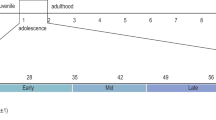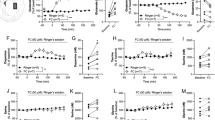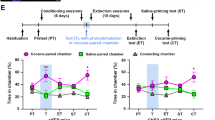Abstract
New research suggests that the modulation of dopamine neurocircuitry by glutamate plays a key role in the development of nicotine and other addictions. For example, manipulation of glutamatergic pathways can alter the mood-enhancing and reinforcing properties of nicotine. These glutamatergic pathways are also sensitive to manipulation by other drugs of abuse. The studies described in this special issue of Neuropsychopharmacology bring together rodent studies with translational work in humans to enhance our understanding of the cellular mechanisms underlying the subjective and objective effects of drugs of abuse. These studies suggest new therapeutic targets based on central glutamate systems that may lead to the development of novel and more effective treatments for addictive disorders.
Similar content being viewed by others
Log in or create a free account to read this content
Gain free access to this article, as well as selected content from this journal and more on nature.com
or
References
Anthenelli RM, Blom TJ, McElroy SL, Keck Jr PE (2008). Preliminary evidence for gender-specific effects of topiramate as a potential aid to smoking cessation. Addiction 103: 687–694.
Bailey C (2005). E-Journal of the British Pharmacological Society. pA2 Online 3: 3.
Brody AL, Mandelkern MA, Olmstead RE, Allen-Martinez Z, Scheibal D, Abrams AL et al (2008). Ventral striatal dopamine release in response to smoking a regular vs a denicotinized cigarette. Neuropsychopharmacol. (in press).
Counotte DS, Spijker S, Van de Burgwal LH, Hogenboom F, Schoffelmeer ANM, De Vries TJ et al (2008). Long-lasting cognitive deficits resulting from adolescent nicotine exposure in rats. Neuropsychopharmacol. (in press).
George TP, Vessicchio JC, Sacco KA, Weinberger AH, Shytle RD (2008). Nicotinic antagonist augmentation of selective serotonin reuptake inhibitor-refractory major depressive disorder: a preliminary study. J Clin Psychopharmacol 28: 340–344.
Heikkinen AE, Moykkyen TP, Korpi ER (2008). Long-lasting modulation of glutamatergic transmission in VTA dopamine neurons after a single dose of benzodiazepine agonists. Neuropsychopharmacol. (in press).
Jackson A, Nesic J, Groombridge C, Clowry O, Rusted J, Duka T. (2008). Differential involvement of glutamatergic mechanisms in the cognitive and subjective effects of smoking. Neuropsychopharmacol. (in press).
Johnson BA, Rosenthal N, Capece JA, Wiegand F, Mao L, Beyers K et al (2007). Topiramate for treating alcohol dependence: a randomized controlled trial. JAMA 298: 1641–1651.
Kenny PJ, Chartoff E, Roberto M, Carlezon Jr WA, Markou A (2008). NMDA receptors regulate nicotine-enhanced brain reward function and intravenous nicotine self-administration: role of the ventral tegmental area and central nucleus of the amygdala. Neuropsychopharmacol. (in press).
LaRowe SD, Myrick H, Hedden S, Mardikian P, Saladin M, McRae A et al (2007). Is cocaine desire reduced by N-acetylcysteine? Am J Psychiatry 164: 1115–1117.
Mineur YS, Somenzi O, Picciotto MR (2007). Cytisine, a partial agonist of high-affinity nicotinic acetylcholine receptors, has antidepressant-like properties in male C57BL/6J mice. Neuropharmacology 52: 1256–1262.
Schultz W (1999). The reward signal of midbrain dopamine neurons. News Physiol Sci 14: 249–255.
Xiao C, Shao XM, Olive MO, Griffin III WC, Li K-Y, Krnjevic K et al (2008). Ethanol facilitates glutamatergic transmission to dopamine neurons in the ventral tegmental area. Neuropsychopharmacol. (in press).
Author information
Authors and Affiliations
Corresponding author
Additional information
DISCLOSURES
Dr Lambe is supported by a Canada Research Chair in Developmental Cortical Neurophysiology, the Canada Foundation for Innovation (CFI) and the Canadian Institutes of Health Research (CIHR). Dr George is a consultant on addiction medications for Pfizer, Eli Lily, Prempharm, and Evotec, and has grant support from Pfizer, Sepracor, Targacept Inc., the National Institute on Drug Abuse (NIDA; grants K02-DA-16611 and R01-DA-15757), the National Alliance for Research on Schizophrenia and Depression (NARSAD), CIHR, CFI and the Endowed Chair in Addiction Psychiatry at the University of Toronto.
Rights and permissions
About this article
Cite this article
Lambe, E., George, T. Perspective: Translational Studies on Glutamate and Dopamine Neurocircuitry in Addictions: Implications for Addiction Treatment. Neuropsychopharmacol 34, 255–256 (2009). https://doi.org/10.1038/npp.2008.196
Received:
Accepted:
Published:
Issue date:
DOI: https://doi.org/10.1038/npp.2008.196



